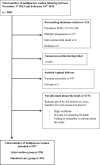Midwives' Management during the Second Stage of Labor in Relation to Second-Degree Tears-An Experimental Study
- PMID: 27859542
- PMCID: PMC5324579
- DOI: 10.1111/birt.12267
Midwives' Management during the Second Stage of Labor in Relation to Second-Degree Tears-An Experimental Study
Abstract
Introduction: Most women who give birth for the first time experience some form of perineal trauma. Second-degree tears contribute to long-term consequences for women and are a risk factor for occult anal sphincter injuries. The objective of this study was to evaluate a multifaceted midwifery intervention designed to reduce second-degree tears among primiparous women.
Methods: An experimental cohort study where a multifaceted intervention consisting of 1) spontaneous pushing, 2) all birth positions with flexibility in the sacro-iliac joints, and 3) a two-step head-to-body delivery was compared with standard care. Crude and Adjusted OR (95% CI) were calculated between the intervention and the standard care group, for the various explanatory variables.
Results: A total of 597 primiparous women participated in the study, 296 in the intervention group and 301 in the standard care group. The prevalence of second-degree tears was lower in the intervention group: [Adj. OR 0.53 (95% CI 0.33-0.84)]. A low prevalence of episiotomy was found in both groups (1.7 and 3.0%). The prevalence of epidural analgesia was 61.1 percent. Despite the high use of epidural analgesia, the midwives in the intervention group managed to use the intervention.
Conclusion: It is possible to reduce second-degree tears among primiparous women with the use of a multifaceted midwifery intervention without increasing the prevalence of episiotomy. Furthermore, the intervention is possible to employ in larger maternity wards with midwives caring for women with both low- and high-risk pregnancies.
Keywords: birth position; midwifery intervention; second-degree tears; spontaneous pushing; two-step delivery.
© 2016 The Authors. Birth published by Wiley Periodicals, Inc.
Figures
References
-
- Samuelsson E, Ladfors L, Lindblom BG, Hagberg H. A prospective observational study on tears during vaginal delivery: Occurrences and risk factors. Acta Obstet Gynecol Scand 2002;81(1):44–49. - PubMed
-
- de Leeuw JW, Struijk PC, Vierhout ME, Wallenburg HC. Risk factors for third degree perineal ruptures during delivery. BJOG 2001;108(4):383–387. - PubMed
-
- Andrews V, Thakar R, Sultan AH, Jones PW. Evaluation of postpartum perineal pain and dyspareunia–A prospective study. Eur J Obstet Gynecol Reprod Biol 2008;137(2):152–156. - PubMed
-
- Dannecker C, Hillemanns P, Strauss A, et al. Episiotomy and perineal tears presumed to be imminent: Randomized controlled trial. Acta Obstet Gynecol Scand 2004;83(4):364–368. - PubMed
-
- Radestad I, Olsson A, Nissen E, Rubertsson C. Tears in the vagina, perineum, sphincter ani, and rectum and first sexual intercourse after childbirth: A nationwide follow‐up. Birth (Berkeley, Calif) 2008;35(2):98–106. - PubMed
Publication types
MeSH terms
LinkOut - more resources
Full Text Sources
Other Literature Sources
Medical


